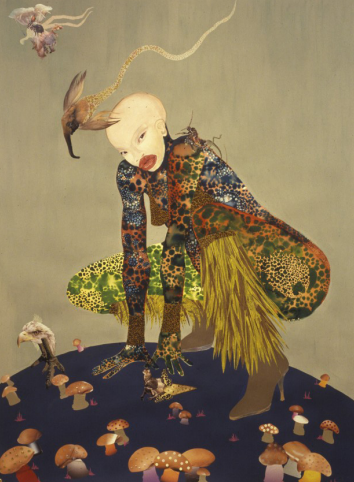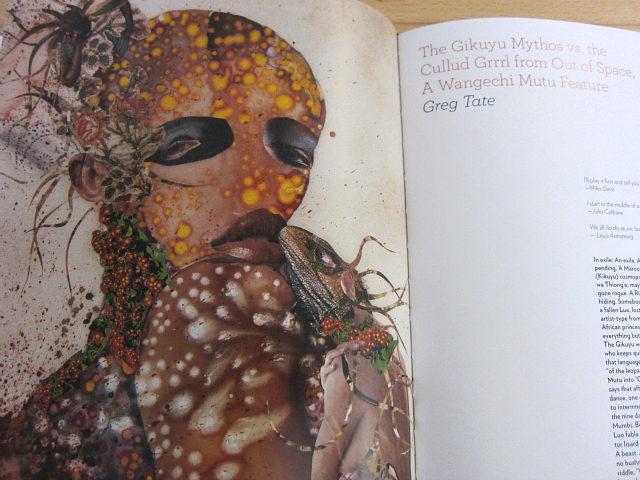The work I chose to project as my ‘least favourite’ was Wangechi Mutu’s ‘Riding Death in My Sleep’. I chose this work as it was the most unappealing and repelling image for me personally because of its imagery and colours.

ANALYSIS
This work, which is created with ink and collage on paper, is an example of pyramidal composition, with the prominent figure (of which is assumed to be a woman) in the centre foreground of the image. There are a 2 smaller, less prominent figures in the top third of the work. The colours used in this work can be described as ‘muddy’ and ‘off-putting’ with some small injections of bright colour on the figure itself. The ‘woman-like’ creature perches atop a mound covered in mushrooms next to an eagle head and 2 unrecognisable flying figures with long tails. The ‘woman’s’ facial features are not contained to one race (African-American features with white skin and almost Asian eyes). These elements begin a conversation about multiculturalism, the female form, racism, feelings of being on the ‘outside’ and comfortability with heritage and race. Her gaze destroys the fourth wall and invites the viewer in but, also repels them at the same time. It brings into question the idea of female sexuality and lust, is whether or not she is grotesque a barrier to this sense of invitation and sexuality?
By employing the technique of collage, Mutu is able to convey a ‘mish-mash’ imagery that reflects into the meanings behind her work. By using this technique she is able to give meaning to every aspect of the work, not just the main focal points, but to every figure and space. By combining different creatures and elements, she is confusing the viewer and this can lead to a sense of unease or curiosity.
This work was created in 2002 in New York but, the artist Wangechi Mutu was born and raised in Kenya. This fact becomes very important when one looks further into Mutu’s catalogue of works. Mutu’s works also represent her interest in feminism and how women are portrayed in today’s society and, some of her works are based off of this idea, with this particular one displaying a juxtaposition between the grotesque, yet sexual imagery in this work vs. the sexual imagery of women we see every day in predominantly Western society. She also cites ‘Afrofuturism’ as the movement with which her works align themselves. ‘Afrofuturism’ is defined as the resurgence and re-imagination of African culture and tradition that “projects techno-futuristic possibilities”. Mutu incorporates this into her work by including African traditional iconography and symbolic features that represent her heritage in her futurist works, bringing tradition and age-old iconography into the 21st century. A lot of Mutu’s works explore black feminity also.
Mutu’s works have similar ideas to those of collage artist Eugenia Loli. They both employ the collage style and also the idea of woman’s place in society and strive to challenge the expectation of female beauty today. The best examples of this in Eugenia’s works are: ‘Freud vs Jung’, ‘Surreal Lovers’ and ‘Gold Digging’. Although these works don’t have quite the same grotesque nature as Mutu’s, the ideologies behind them are similar.
This work has been displayed in many different exhibitions across America, but, perhaps the most concise example of how this work was exhibited would be in Mutu’s book ‘Wangechi Mutu: A Fantastic Journey’ in which she details all of her work included in her travelling exhibition. Most of these pieces are quite similar to ‘Riding Death in My Sleep’, many incorporating the same grotesque imagery and collage style. An example of this is her work ‘Cullud Grrrl from Out of Space’ which also heavily references race and feelings of alienation for women of colour in Western society.

REFERENCES
Wangechi Mutu (Kenyan, b. 1972). Riding Death in My Sleep, 2002. Ink and collage on paper, 60 x 44 inches (152.4 x 111.76 cm). Collection of Peter Norton, New York. © Wangechi Mutu. (n.d.). Retrieved May 21, 2017, from http://magazine.art21.org/2014/01/13/wangechi-mutu-on-failure/mutu-riding-death-in-my-sleep-copy/
Eye, C. (2014). Rethinking African culture and identity: the Afropolitan model. Journal of African Cultural Studies,26(2), 234-237.
Mutu, W. (2010). Wangechi Mutu, artist of the year 2010 : my dirty little heaven. Ostfildern-Ruit.
Mancoff, D. N. (n.d.). Encyclopedia Britannica.
Gallery, S. (n.d.). Wangechi Mutu. Retrieved May 21, 2017, from http://www.saatchigallery.com/artists/wangechi_mutu.htm
Wangechi Mutu (Kenyan, b. 1972). Riding Death in My Sleep, 2002. Ink and collage on paper, 60 x 44 inches (152.4 x 111.76 cm). Collection of Peter Norton, New York. © Wangechi Mutu. (n.d.). Retrieved May 21, 2017, from http://magazine.art21.org/2014/01/13/wangechi-mutu-on-failure/mutu-riding-death-in-my-sleep-copy/
Meier, A. (2013, August 05). The Grotesque Beauty of Wangechi Mutu. Retrieved May 21, 2017, from https://hyperallergic.com/77092/the-grotesque-beauty-of-wangechi-mutu/
In Past ShowWangechi Mutu: A Fantastic Journey at Brooklyn Museum. (n.d.). Retrieved May 21, 2017, from https://www.artsy.net/artwork/wangechi-mutu-riding-death-in-my-sleep
Chiwoniso Kaitano for Warscapes, part of the Guardian Africa Network. (2013, November 13). The Afrofuturism of Wangechi Mutu. Retrieved May 21, 2017, from https://www.theguardian.com/world/2013/nov/13/wangechi-mutu-art-afrofuturism
Hansen-Bundy, B., Almanas, P. K., Mechanic, M., Lybarger, J., Joyce, K., Luna, J., . . . Lurie, J. (n.d.). A fantastic journey into the mind of collage artist Wangechi Mutu. Retrieved May 21, 2017, from http://www.motherjones.com/media/2013/10/interview-collage-artist-wangechi-mutu-fantastic-journey
IMAGE REFERENCES
Mutu, Wanchegi. Riding Death In My Sleep. New York: N.p., 2002. Print.
Loli, Eugenia. Freud Vs Jung. Print.
Loli, Eugenia. Gold Digging. Print.
Loli, Eugenia. Surreal Lovers. Print.


